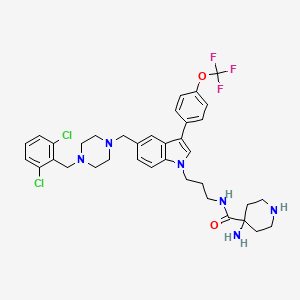
Rifampicin
- Click on QUICK INQUIRY to receive a quote from our team of experts.
- With the quality product at a COMPETITIVE price, you can focus more on your research.
Overview
Description
Mechanism of Action
Target of Action
Mode of Action
Pharmacokinetics
Action Environment
Biochemical Analysis
Biochemical Properties
Rifampicin plays a crucial role in biochemical reactions by inhibiting the bacterial DNA-dependent RNA polymerase (RNAP) . This inhibition prevents the transcription of bacterial DNA into RNA, effectively halting protein synthesis and leading to bacterial cell death . This compound interacts with several biomolecules, including the β-subunit of RNAP, forming a stable drug-enzyme complex . This interaction is highly specific and does not affect the corresponding mammalian enzymes .
Cellular Effects
This compound exerts significant effects on various types of cells and cellular processes. In bacterial cells, it inhibits transcription by binding to the β-subunit of RNAP, leading to the cessation of RNA synthesis . This inhibition disrupts essential cellular functions, including cell signaling pathways, gene expression, and cellular metabolism . In human hepatocytes, this compound alters the expression of several drug transporter genes, impacting drug metabolism and transport .
Molecular Mechanism
The molecular mechanism of this compound involves its binding to the β-subunit of bacterial RNAP, forming a stable drug-enzyme complex with a binding constant of 10^-9 M at 37°C . This binding physically blocks the elongation of the RNA chain, preventing the synthesis of bacterial proteins . Additionally, this compound activates nuclear pregnane X receptors (PXRs), leading to amplified gene transcriptions .
Temporal Effects in Laboratory Settings
In laboratory settings, the effects of this compound can vary over time. Studies have shown that this compound’s efficacy is influenced by factors such as cell cycle stage and growth pole age in mycobacteria . The drug’s stability and degradation also play a role in its long-term effects on cellular function. For instance, this compound’s maximum concentration (Cmax) and area under the concentration-time curve (AUC) are critical predictors of its sterilizing activity and therapeutic efficacy .
Dosage Effects in Animal Models
The effects of this compound vary with different dosages in animal models. In horses, the dosage ranges from 5 to 10 mg/kg, administered orally every 12 to 24 hours . Higher doses have been associated with increased efficacy but also with potential adverse effects such as hepatic tumors in female mice . In mice, computational pharmacology studies have shown that optimal dosing can balance therapeutic efficacy and minimize adverse effects .
Metabolic Pathways
This compound is a potent inducer of the hepatic cytochrome P450 enzyme system, including isoenzymes CYP2B6, CYP2C8, CYP2C9, CYP2C19, CYP3A4, CYP3A5, and CYP3A7 . This induction leads to increased metabolism of various drugs, affecting their pharmacokinetics and pharmacodynamics . This compound-mediated metabolic changes in Mycobacterium tuberculosis involve alterations in pyrimidine, purine, arginine, phenylalanine, tyrosine, and tryptophan metabolic pathways .
Transport and Distribution
This compound is highly lipophilic and is 80% bound to plasma proteins, primarily α-1-acid-glycoprotein . It is widely distributed in body tissues and fluids due to its high lipid solubility . In human hepatocytes, this compound alters the expression of several drug transporter genes, including ABCC2, ABCB1, and ABCC3, impacting its transport and distribution within cells .
Subcellular Localization
This compound’s subcellular localization is influenced by its interaction with various biomolecules. In bacterial cells, this compound’s confinement is dependent on active transcription, with a majority of particles showing nucleoid occlusion and confined motion . This localization is crucial for its activity, as it ensures that this compound effectively inhibits RNAP and disrupts bacterial protein synthesis .
Preparation Methods
Synthetic Routes and Reaction Conditions: Rifampicin is synthesized from rifamycin S. The process involves reacting rifamycin S with 1-amino-4-methylpiperazine in an aprotic dipolar solvent at temperatures ranging from 20°C to 100°C . The reaction is typically carried out in a microreactor to improve efficiency and yield .
Industrial Production Methods: Industrial production of this compound involves a continuous flow synthesis starting from rifamycin S and tert-butylamine. This method includes two reaction steps and one purification step, resulting in a 67% overall yield . The process is designed to reduce the consumption of 1-amino-4-methylpiperazine and improve overall efficiency .
Chemical Reactions Analysis
Types of Reactions: Rifampicin undergoes various chemical reactions, including oxidation, reduction, and substitution.
Common Reagents and Conditions:
Oxidation: this compound can be oxidized using mild oxidizing agents to form 3-formylrifamycin SV.
Reduction: The reduction of this compound involves the use of reducing agents like sodium borohydride.
Major Products: The major products formed from these reactions include various derivatives of this compound, such as 3-formylrifamycin SV and its subsequent derivatives .
Scientific Research Applications
Rifampicin has a wide range of scientific research applications:
Comparison with Similar Compounds
- Rifabutin
- Rifapentine
- Rifaximin
Rifampicin’s unique properties and broad-spectrum activity make it a vital antibiotic in the treatment of various bacterial infections.
Properties
CAS No. |
13292-46-1 |
|---|---|
Molecular Formula |
C43H58N4O12 |
Molecular Weight |
822.9 g/mol |
IUPAC Name |
[(7S,11S,12R,13S,14R,15R,16R,17S,18S,19Z,21Z)-2,15,17,27,29-pentahydroxy-11-methoxy-3,7,12,14,16,18,22-heptamethyl-26-[(E)-(4-methylpiperazin-1-yl)iminomethyl]-6,23-dioxo-8,30-dioxa-24-azatetracyclo[23.3.1.14,7.05,28]triaconta-1(29),2,4,9,19,21,25,27-octaen-13-yl] acetate |
InChI |
InChI=1S/C43H58N4O12/c1-21-12-11-13-22(2)42(55)45-33-28(20-44-47-17-15-46(9)16-18-47)37(52)30-31(38(33)53)36(51)26(6)40-32(30)41(54)43(8,59-40)57-19-14-29(56-10)23(3)39(58-27(7)48)25(5)35(50)24(4)34(21)49/h11-14,19-21,23-25,29,34-35,39,49-53H,15-18H2,1-10H3,(H,45,55)/b12-11-,19-14?,22-13-,44-20+/t21-,23+,24+,25+,29-,34-,35+,39+,43-/m0/s1 |
InChI Key |
JQXXHWHPUNPDRT-CHTVYFSYSA-N |
SMILES |
CC1C=CC=C(C(=O)NC2=C(C(=C3C(=C2O)C(=C(C4=C3C(=O)C(O4)(OC=CC(C(C(C(C(C(C1O)C)O)C)OC(=O)C)C)OC)C)C)O)O)C=NN5CCN(CC5)C)C |
Isomeric SMILES |
C[C@H]1/C=C\C=C(/C(=O)NC2=C(C(=C3C(=C2O)C(=C(C4=C3C(=O)[C@](O4)(OC=C[C@@H]([C@H]([C@H]([C@@H]([C@@H]([C@@H]([C@H]1O)C)O)C)OC(=O)C)C)OC)C)C)O)O)/C=N/N5CCN(CC5)C)\C |
Canonical SMILES |
CC1C=CC=C(C(=O)NC2=C(C(=C3C(=C2O)C(=C(C4=C3C(=O)C(O4)(OC=CC(C(C(C(C(C(C1O)C)O)C)OC(=O)C)C)OC)C)C)O)O)C=NN5CCN(CC5)C)C |
Appearance |
Solid powder |
Color/Form |
Red to orange platelets from acetone Red-brown crystalline powde |
melting_point |
Decomposes 183-188 °C |
Purity |
>98% (or refer to the Certificate of Analysis) |
shelf_life |
>2 years if stored properly |
solubility |
Freely sol in methyl chloride, dimethyl sulfoxide; sol in tetrahydrofuran; slightly sol in water (pH less than 6), acetone, carbon tetrachloride Freely soluble in chloroform, soluble in ethyl acetate and in methanol. In water, 1,400 mg/L at 25 °C |
storage |
Dry, dark and at 0 - 4 C for short term (days to weeks) or -20 C for long term (months to years). |
Synonyms |
Rifampicin; Rifadin; Rifampin; Rimactane; Rimactan; Tubocin; Archidyn; Arficin; Arzide; Benemicin; Doloresum; Eremfat; Fenampicin; Sinerdol; |
vapor_pressure |
3.1X10-34 mm Hg at 25 °C /Estimated/ |
Origin of Product |
United States |
Q1: How does rifampicin exert its antibacterial effect?
A1: this compound specifically targets bacterial DNA-dependent RNA polymerase, the enzyme responsible for RNA synthesis [, , ]. It binds to the β subunit of the polymerase encoded by the rpoB gene, effectively blocking transcription initiation [, , ]. This inhibition of RNA synthesis ultimately leads to bacterial cell death [].
Q2: What is the molecular formula and weight of this compound?
A2: this compound has a molecular formula of C43H58N4O12 and a molecular weight of 822.95 g/mol.
Q3: Is there any spectroscopic data available for this compound?
A3: While the provided articles primarily focus on clinical and biological aspects, this compound's structure is well characterized. Spectroscopic data, including UV-Vis, infrared, and NMR spectra, can be found in various chemical databases and publications.
Q4: How stable is this compound under different storage conditions?
A4: The stability of this compound in various formulations and storage conditions has been extensively studied. It is generally stable in solid form, but its degradation rate increases in acidic and alkaline solutions [].
Q5: Does this compound possess any catalytic properties?
A5: this compound is not known to exhibit catalytic properties in the traditional sense. Its mode of action primarily involves binding and inhibiting bacterial RNA polymerase rather than catalyzing a chemical reaction.
Q6: Have any computational studies been conducted on this compound?
A6: Although not explicitly detailed in the provided papers, computational studies have been conducted on this compound to explore its interactions with RNA polymerase and design derivatives with improved activity.
Q7: How do modifications to the this compound structure affect its activity?
A7: Research has shown that even minor changes to the this compound structure, particularly in the rifamycin core, can drastically affect its binding affinity for RNA polymerase and its antibacterial activity [, , ].
Q8: What are some common formulation strategies used to improve the stability or bioavailability of this compound?
A8: this compound is commonly formulated as capsules or tablets. Various strategies are employed to improve its stability, including controlling particle size, using different excipients, and developing specific drug delivery systems.
Q9: What is known about the absorption, distribution, metabolism, and excretion (ADME) of this compound?
A9: this compound is well-absorbed orally and widely distributed throughout the body, including achieving therapeutic concentrations in various tissues and fluids [, , , , ]. It is primarily metabolized in the liver and excreted in bile and urine. Notably, it can induce its own metabolism, decreasing its half-life during treatment [, ].
Q10: How does the administration route of this compound affect its pharmacokinetic profile in elderly patients with tuberculosis?
A10: One study indicated that intravenous administration of this compound in elderly tuberculosis patients resulted in better efficacy and fewer gastrointestinal side effects compared to oral administration, highlighting the influence of administration route on the drug's pharmacokinetic profile in specific populations [].
Q11: Does the presence of hyperlipidemia impact the urinary excretion of this compound?
A11: Research suggests a possible association between hyperlipidemia and decreased levels of this compound in the urine of tuberculosis patients []. This finding indicates a potential interaction requiring further investigation to understand the clinical implications fully.
Q12: Has this compound demonstrated efficacy against biofilm-forming bacteria?
A12: Studies have shown that this compound's efficacy against biofilm-forming bacteria, particularly Staphylococcus aureus, is limited, even in combination with other antibiotics [, ]. This compound alone often fails to eradicate mature biofilms, and resistance can emerge rapidly [, , ].
Q13: Is this compound effective in treating extrapulmonary tuberculosis?
A13: Research indicates that the efficacy of this compound in treating extrapulmonary tuberculosis varies depending on the site of infection and the specimen tested []. It is crucial to interpret Xpert MTB/RIF assay results cautiously, especially in cases of tuberculous meningitis, where treatment decisions should consider clinical judgment alongside test results [].
Q14: What are the mechanisms of resistance to this compound in Mycobacterium tuberculosis?
A14: Resistance to this compound in M. tuberculosis is primarily mediated by mutations in the rpoB gene, which encodes the β subunit of RNA polymerase [, ]. These mutations often alter the drug's binding site, leading to decreased susceptibility.
Q15: What is the significance of acquired this compound resistance during first-line tuberculosis treatment?
A15: Acquired this compound resistance during initial tuberculosis treatment is a significant concern []. Understanding the factors contributing to its development, such as treatment regimen and pre-existing isoniazid resistance, is crucial for devising strategies to prevent and manage this challenge [].
Q16: Have any specific drug delivery systems been investigated for this compound?
A16: Research is exploring various drug delivery strategies, including nanoparticles and liposomes, to improve this compound's targeting to specific tissues and enhance its therapeutic efficacy.
Q17: Are there any known biomarkers to predict this compound efficacy or monitor treatment response?
A17: While this compound susceptibility testing is routinely used to guide treatment decisions, research continues to explore potential biomarkers for a more personalized approach to therapy.
Q18: What analytical methods are commonly used for this compound quantification?
A19: High-performance liquid chromatography (HPLC) is widely used to quantify this compound in biological samples [, , ]. Various detection methods, including UV-Vis and mass spectrometry, can be coupled with HPLC for sensitive and accurate measurements.
Disclaimer and Information on In-Vitro Research Products
Please be aware that all articles and product information presented on BenchChem are intended solely for informational purposes. The products available for purchase on BenchChem are specifically designed for in-vitro studies, which are conducted outside of living organisms. In-vitro studies, derived from the Latin term "in glass," involve experiments performed in controlled laboratory settings using cells or tissues. It is important to note that these products are not categorized as medicines or drugs, and they have not received approval from the FDA for the prevention, treatment, or cure of any medical condition, ailment, or disease. We must emphasize that any form of bodily introduction of these products into humans or animals is strictly prohibited by law. It is essential to adhere to these guidelines to ensure compliance with legal and ethical standards in research and experimentation.



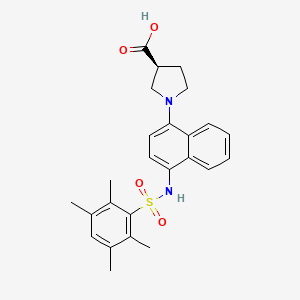

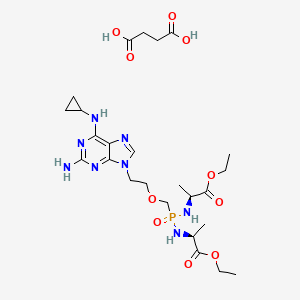

![4-[2-amino-5-[4-[(dimethylamino)methyl]thiophen-2-yl]pyridin-3-yl]-2-[(Z)-5,5,5-trifluoropent-3-en-2-yl]oxybenzamide](/img/structure/B610405.png)
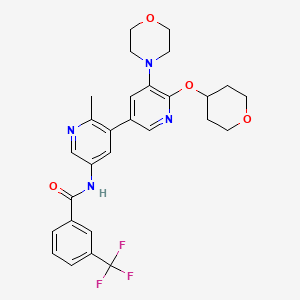
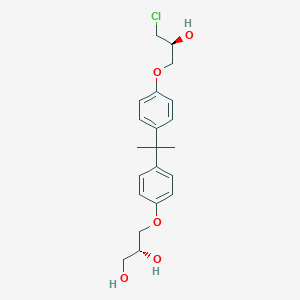
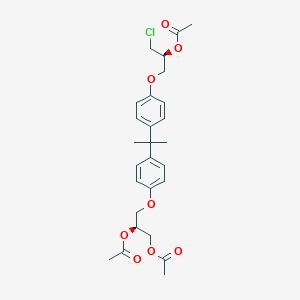
![[(1S,2S,3S,4S,5R,6S,8S,9R,13S,16S,17S)-11-ethyl-3,8,9-trihydroxy-4,6,16-trimethoxy-11-azahexacyclo[7.7.2.12,5.01,10.03,8.013,17]nonadecan-13-yl] 2-acetamidobenzoate](/img/structure/B610416.png)
